Children as Thinkers: Approaches in Early Childhood Education
VerifiedAdded on 2022/08/20
|21
|6407
|17
Essay
AI Summary
This assignment delves into the concept of children as thinkers and meaning makers, focusing on the approaches of Magda Gerber and the Abecedarian method in early childhood education. The paper begins with a literature review of Magda Gerber's approach to infant and toddler care, highlighting its origins and the theoretical orientation it reflects, particularly cognitive-behavioral therapy. The analysis then compares and contrasts Gerber's approach with the Abecedarian method, examining their similarities and differences, especially concerning language acquisition and overall child development. Furthermore, the assignment explores the relationship between Gerber's approach, scaffolding, and the three components of developmentally appropriate practice: child development appropriateness, individual appropriateness, and societal/cultural appropriateness. The paper concludes by emphasizing the interconnectedness of these approaches in fostering children's cognitive and emotional growth, advocating for a holistic understanding of children's learning processes.
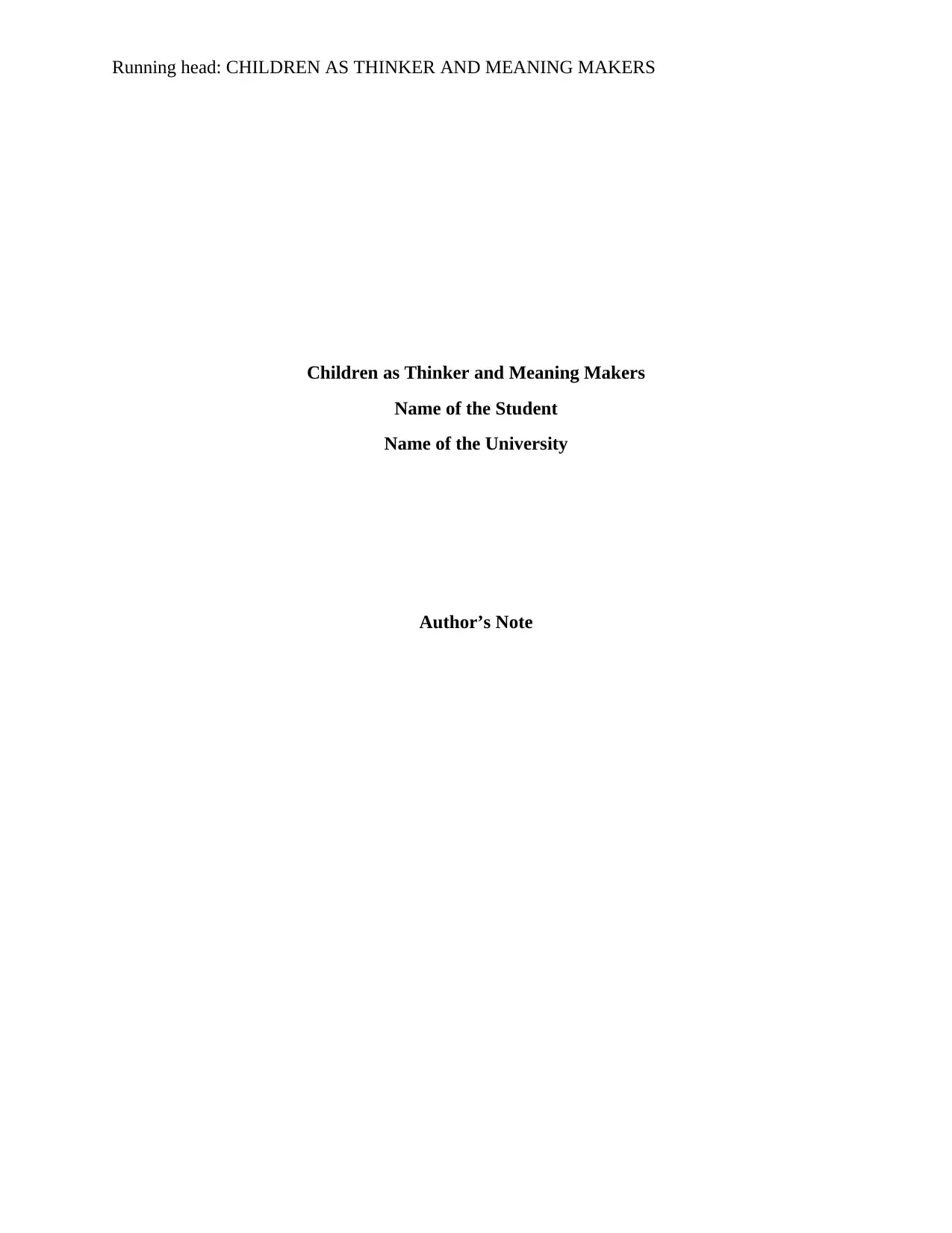
Running head: CHILDREN AS THINKER AND MEANING MAKERS
Children as Thinker and Meaning Makers
Name of the Student
Name of the University
Author’s Note
Children as Thinker and Meaning Makers
Name of the Student
Name of the University
Author’s Note
Paraphrase This Document
Need a fresh take? Get an instant paraphrase of this document with our AI Paraphraser
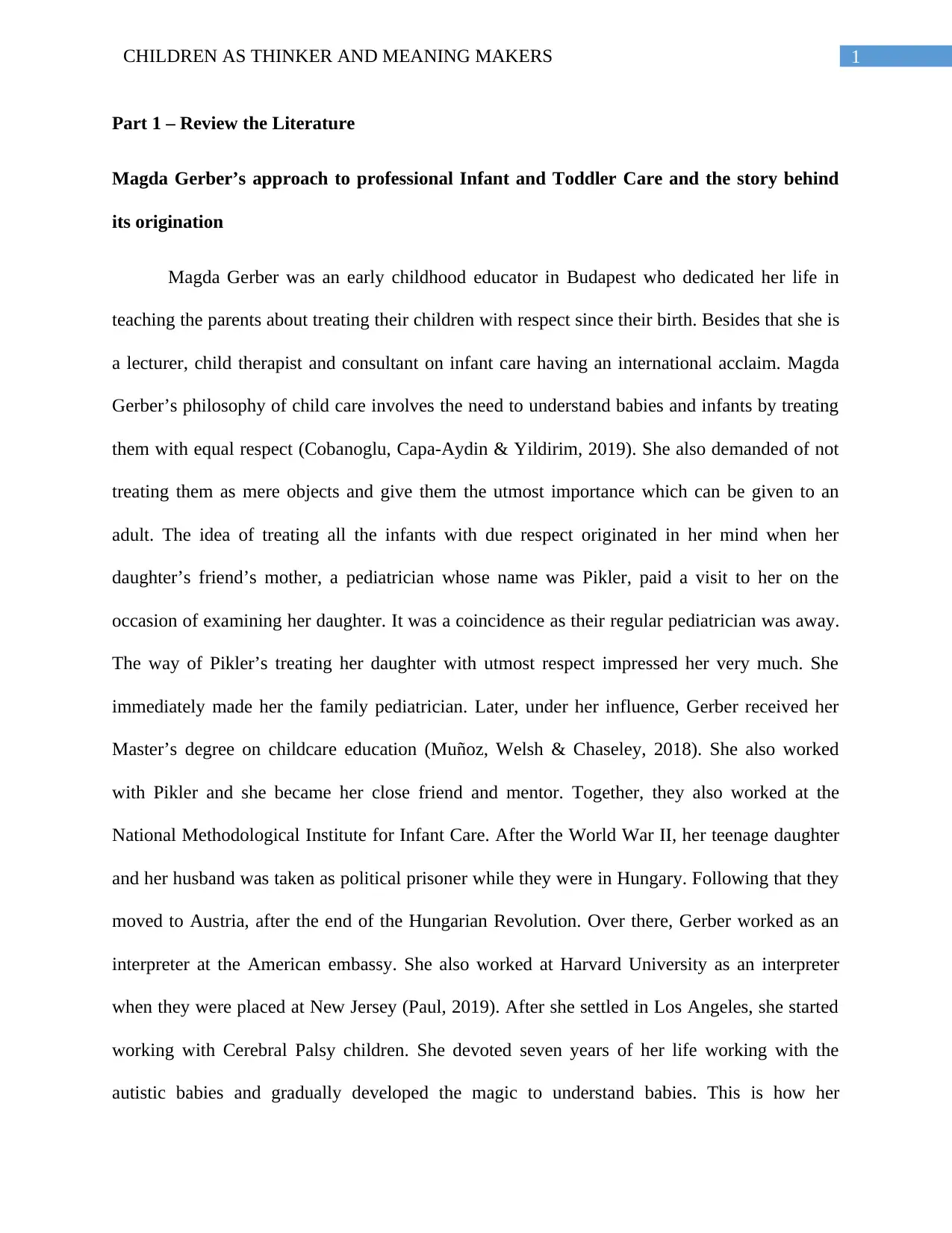
1CHILDREN AS THINKER AND MEANING MAKERS
Part 1 – Review the Literature
Magda Gerber’s approach to professional Infant and Toddler Care and the story behind
its origination
Magda Gerber was an early childhood educator in Budapest who dedicated her life in
teaching the parents about treating their children with respect since their birth. Besides that she is
a lecturer, child therapist and consultant on infant care having an international acclaim. Magda
Gerber’s philosophy of child care involves the need to understand babies and infants by treating
them with equal respect (Cobanoglu, Capa-Aydin & Yildirim, 2019). She also demanded of not
treating them as mere objects and give them the utmost importance which can be given to an
adult. The idea of treating all the infants with due respect originated in her mind when her
daughter’s friend’s mother, a pediatrician whose name was Pikler, paid a visit to her on the
occasion of examining her daughter. It was a coincidence as their regular pediatrician was away.
The way of Pikler’s treating her daughter with utmost respect impressed her very much. She
immediately made her the family pediatrician. Later, under her influence, Gerber received her
Master’s degree on childcare education (Muñoz, Welsh & Chaseley, 2018). She also worked
with Pikler and she became her close friend and mentor. Together, they also worked at the
National Methodological Institute for Infant Care. After the World War II, her teenage daughter
and her husband was taken as political prisoner while they were in Hungary. Following that they
moved to Austria, after the end of the Hungarian Revolution. Over there, Gerber worked as an
interpreter at the American embassy. She also worked at Harvard University as an interpreter
when they were placed at New Jersey (Paul, 2019). After she settled in Los Angeles, she started
working with Cerebral Palsy children. She devoted seven years of her life working with the
autistic babies and gradually developed the magic to understand babies. This is how her
Part 1 – Review the Literature
Magda Gerber’s approach to professional Infant and Toddler Care and the story behind
its origination
Magda Gerber was an early childhood educator in Budapest who dedicated her life in
teaching the parents about treating their children with respect since their birth. Besides that she is
a lecturer, child therapist and consultant on infant care having an international acclaim. Magda
Gerber’s philosophy of child care involves the need to understand babies and infants by treating
them with equal respect (Cobanoglu, Capa-Aydin & Yildirim, 2019). She also demanded of not
treating them as mere objects and give them the utmost importance which can be given to an
adult. The idea of treating all the infants with due respect originated in her mind when her
daughter’s friend’s mother, a pediatrician whose name was Pikler, paid a visit to her on the
occasion of examining her daughter. It was a coincidence as their regular pediatrician was away.
The way of Pikler’s treating her daughter with utmost respect impressed her very much. She
immediately made her the family pediatrician. Later, under her influence, Gerber received her
Master’s degree on childcare education (Muñoz, Welsh & Chaseley, 2018). She also worked
with Pikler and she became her close friend and mentor. Together, they also worked at the
National Methodological Institute for Infant Care. After the World War II, her teenage daughter
and her husband was taken as political prisoner while they were in Hungary. Following that they
moved to Austria, after the end of the Hungarian Revolution. Over there, Gerber worked as an
interpreter at the American embassy. She also worked at Harvard University as an interpreter
when they were placed at New Jersey (Paul, 2019). After she settled in Los Angeles, she started
working with Cerebral Palsy children. She devoted seven years of her life working with the
autistic babies and gradually developed the magic to understand babies. This is how her
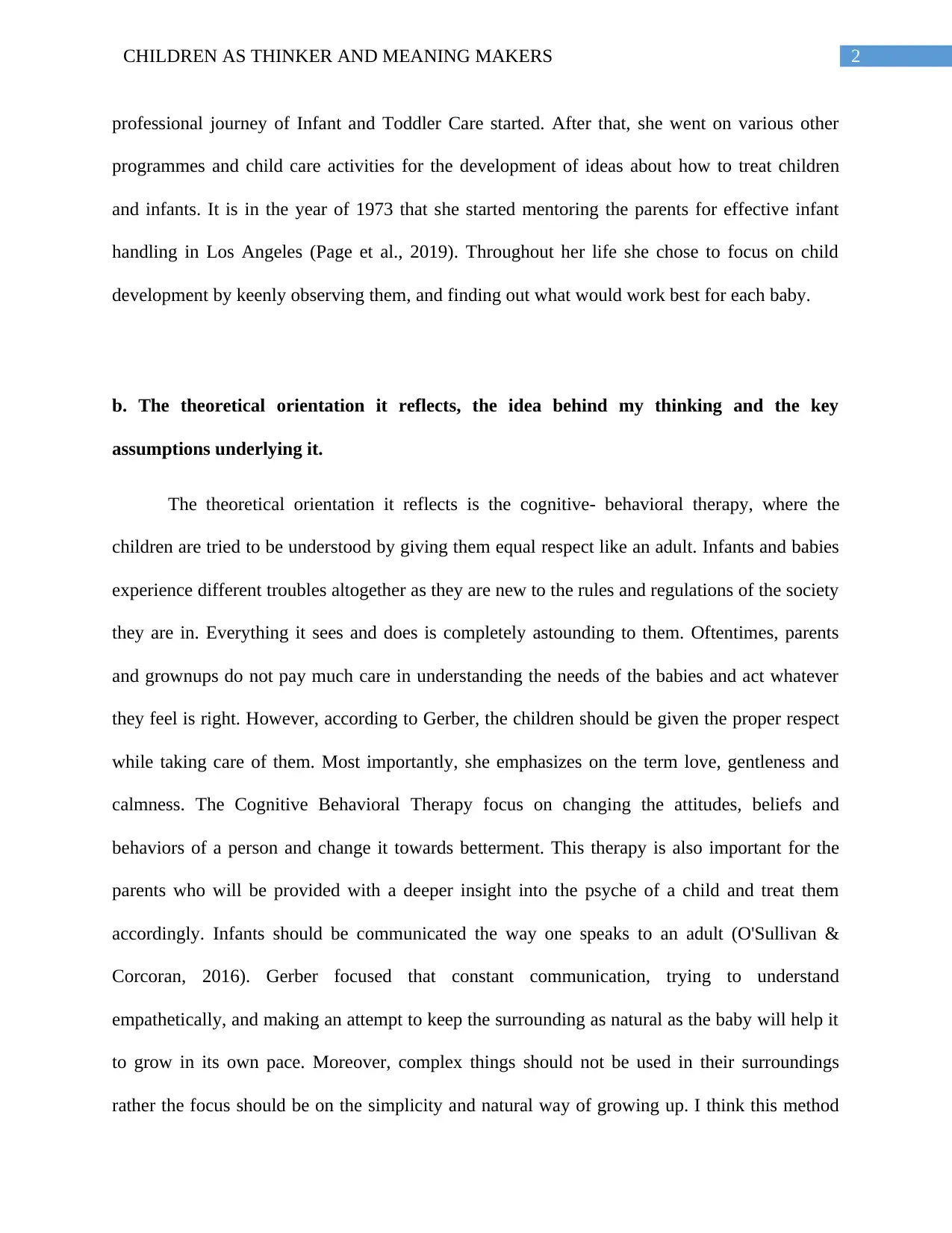
2CHILDREN AS THINKER AND MEANING MAKERS
professional journey of Infant and Toddler Care started. After that, she went on various other
programmes and child care activities for the development of ideas about how to treat children
and infants. It is in the year of 1973 that she started mentoring the parents for effective infant
handling in Los Angeles (Page et al., 2019). Throughout her life she chose to focus on child
development by keenly observing them, and finding out what would work best for each baby.
b. The theoretical orientation it reflects, the idea behind my thinking and the key
assumptions underlying it.
The theoretical orientation it reflects is the cognitive- behavioral therapy, where the
children are tried to be understood by giving them equal respect like an adult. Infants and babies
experience different troubles altogether as they are new to the rules and regulations of the society
they are in. Everything it sees and does is completely astounding to them. Oftentimes, parents
and grownups do not pay much care in understanding the needs of the babies and act whatever
they feel is right. However, according to Gerber, the children should be given the proper respect
while taking care of them. Most importantly, she emphasizes on the term love, gentleness and
calmness. The Cognitive Behavioral Therapy focus on changing the attitudes, beliefs and
behaviors of a person and change it towards betterment. This therapy is also important for the
parents who will be provided with a deeper insight into the psyche of a child and treat them
accordingly. Infants should be communicated the way one speaks to an adult (O'Sullivan &
Corcoran, 2016). Gerber focused that constant communication, trying to understand
empathetically, and making an attempt to keep the surrounding as natural as the baby will help it
to grow in its own pace. Moreover, complex things should not be used in their surroundings
rather the focus should be on the simplicity and natural way of growing up. I think this method
professional journey of Infant and Toddler Care started. After that, she went on various other
programmes and child care activities for the development of ideas about how to treat children
and infants. It is in the year of 1973 that she started mentoring the parents for effective infant
handling in Los Angeles (Page et al., 2019). Throughout her life she chose to focus on child
development by keenly observing them, and finding out what would work best for each baby.
b. The theoretical orientation it reflects, the idea behind my thinking and the key
assumptions underlying it.
The theoretical orientation it reflects is the cognitive- behavioral therapy, where the
children are tried to be understood by giving them equal respect like an adult. Infants and babies
experience different troubles altogether as they are new to the rules and regulations of the society
they are in. Everything it sees and does is completely astounding to them. Oftentimes, parents
and grownups do not pay much care in understanding the needs of the babies and act whatever
they feel is right. However, according to Gerber, the children should be given the proper respect
while taking care of them. Most importantly, she emphasizes on the term love, gentleness and
calmness. The Cognitive Behavioral Therapy focus on changing the attitudes, beliefs and
behaviors of a person and change it towards betterment. This therapy is also important for the
parents who will be provided with a deeper insight into the psyche of a child and treat them
accordingly. Infants should be communicated the way one speaks to an adult (O'Sullivan &
Corcoran, 2016). Gerber focused that constant communication, trying to understand
empathetically, and making an attempt to keep the surrounding as natural as the baby will help it
to grow in its own pace. Moreover, complex things should not be used in their surroundings
rather the focus should be on the simplicity and natural way of growing up. I think this method
⊘ This is a preview!⊘
Do you want full access?
Subscribe today to unlock all pages.

Trusted by 1+ million students worldwide
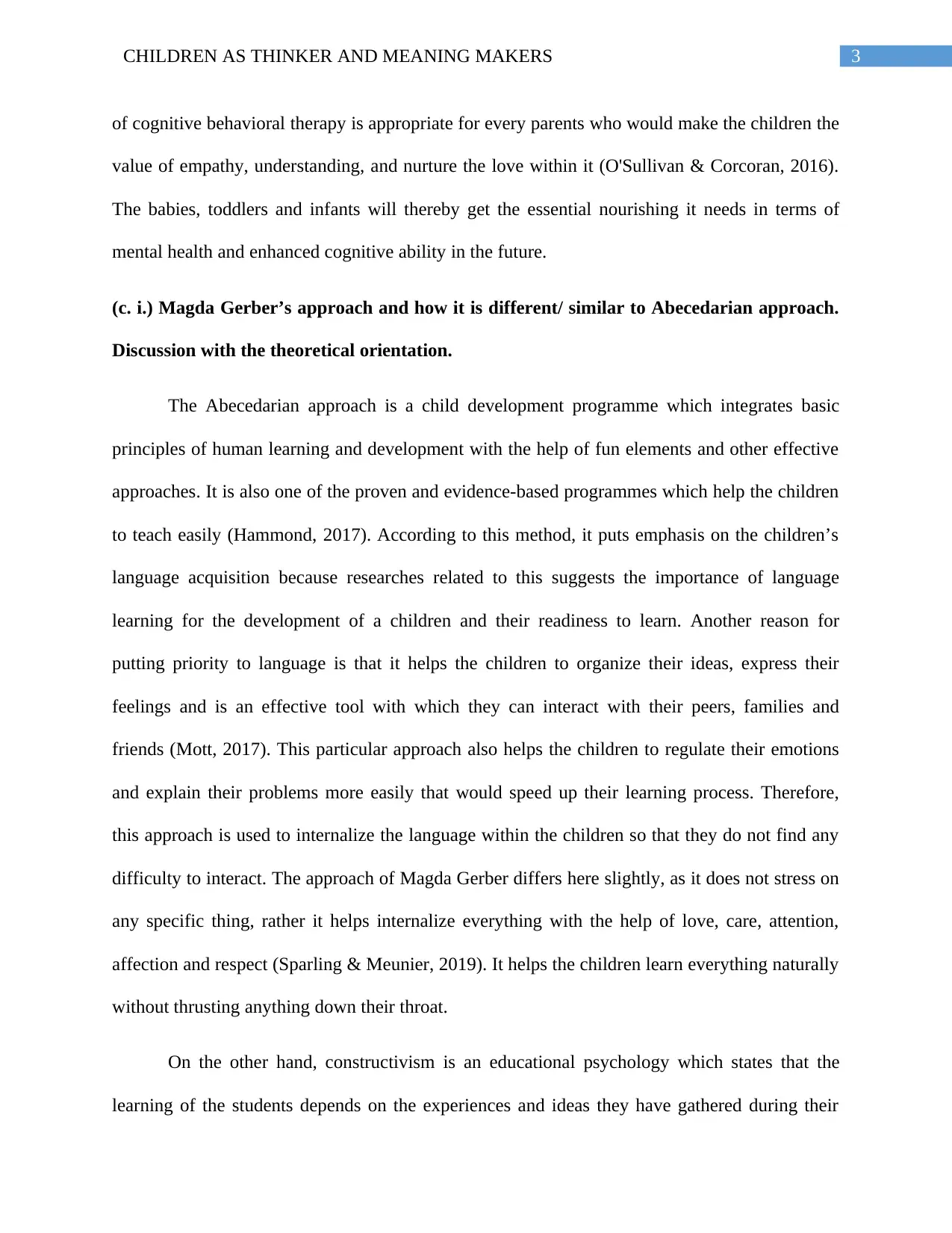
3CHILDREN AS THINKER AND MEANING MAKERS
of cognitive behavioral therapy is appropriate for every parents who would make the children the
value of empathy, understanding, and nurture the love within it (O'Sullivan & Corcoran, 2016).
The babies, toddlers and infants will thereby get the essential nourishing it needs in terms of
mental health and enhanced cognitive ability in the future.
(c. i.) Magda Gerber’s approach and how it is different/ similar to Abecedarian approach.
Discussion with the theoretical orientation.
The Abecedarian approach is a child development programme which integrates basic
principles of human learning and development with the help of fun elements and other effective
approaches. It is also one of the proven and evidence-based programmes which help the children
to teach easily (Hammond, 2017). According to this method, it puts emphasis on the children’s
language acquisition because researches related to this suggests the importance of language
learning for the development of a children and their readiness to learn. Another reason for
putting priority to language is that it helps the children to organize their ideas, express their
feelings and is an effective tool with which they can interact with their peers, families and
friends (Mott, 2017). This particular approach also helps the children to regulate their emotions
and explain their problems more easily that would speed up their learning process. Therefore,
this approach is used to internalize the language within the children so that they do not find any
difficulty to interact. The approach of Magda Gerber differs here slightly, as it does not stress on
any specific thing, rather it helps internalize everything with the help of love, care, attention,
affection and respect (Sparling & Meunier, 2019). It helps the children learn everything naturally
without thrusting anything down their throat.
On the other hand, constructivism is an educational psychology which states that the
learning of the students depends on the experiences and ideas they have gathered during their
of cognitive behavioral therapy is appropriate for every parents who would make the children the
value of empathy, understanding, and nurture the love within it (O'Sullivan & Corcoran, 2016).
The babies, toddlers and infants will thereby get the essential nourishing it needs in terms of
mental health and enhanced cognitive ability in the future.
(c. i.) Magda Gerber’s approach and how it is different/ similar to Abecedarian approach.
Discussion with the theoretical orientation.
The Abecedarian approach is a child development programme which integrates basic
principles of human learning and development with the help of fun elements and other effective
approaches. It is also one of the proven and evidence-based programmes which help the children
to teach easily (Hammond, 2017). According to this method, it puts emphasis on the children’s
language acquisition because researches related to this suggests the importance of language
learning for the development of a children and their readiness to learn. Another reason for
putting priority to language is that it helps the children to organize their ideas, express their
feelings and is an effective tool with which they can interact with their peers, families and
friends (Mott, 2017). This particular approach also helps the children to regulate their emotions
and explain their problems more easily that would speed up their learning process. Therefore,
this approach is used to internalize the language within the children so that they do not find any
difficulty to interact. The approach of Magda Gerber differs here slightly, as it does not stress on
any specific thing, rather it helps internalize everything with the help of love, care, attention,
affection and respect (Sparling & Meunier, 2019). It helps the children learn everything naturally
without thrusting anything down their throat.
On the other hand, constructivism is an educational psychology which states that the
learning of the students depends on the experiences and ideas they have gathered during their
Paraphrase This Document
Need a fresh take? Get an instant paraphrase of this document with our AI Paraphraser
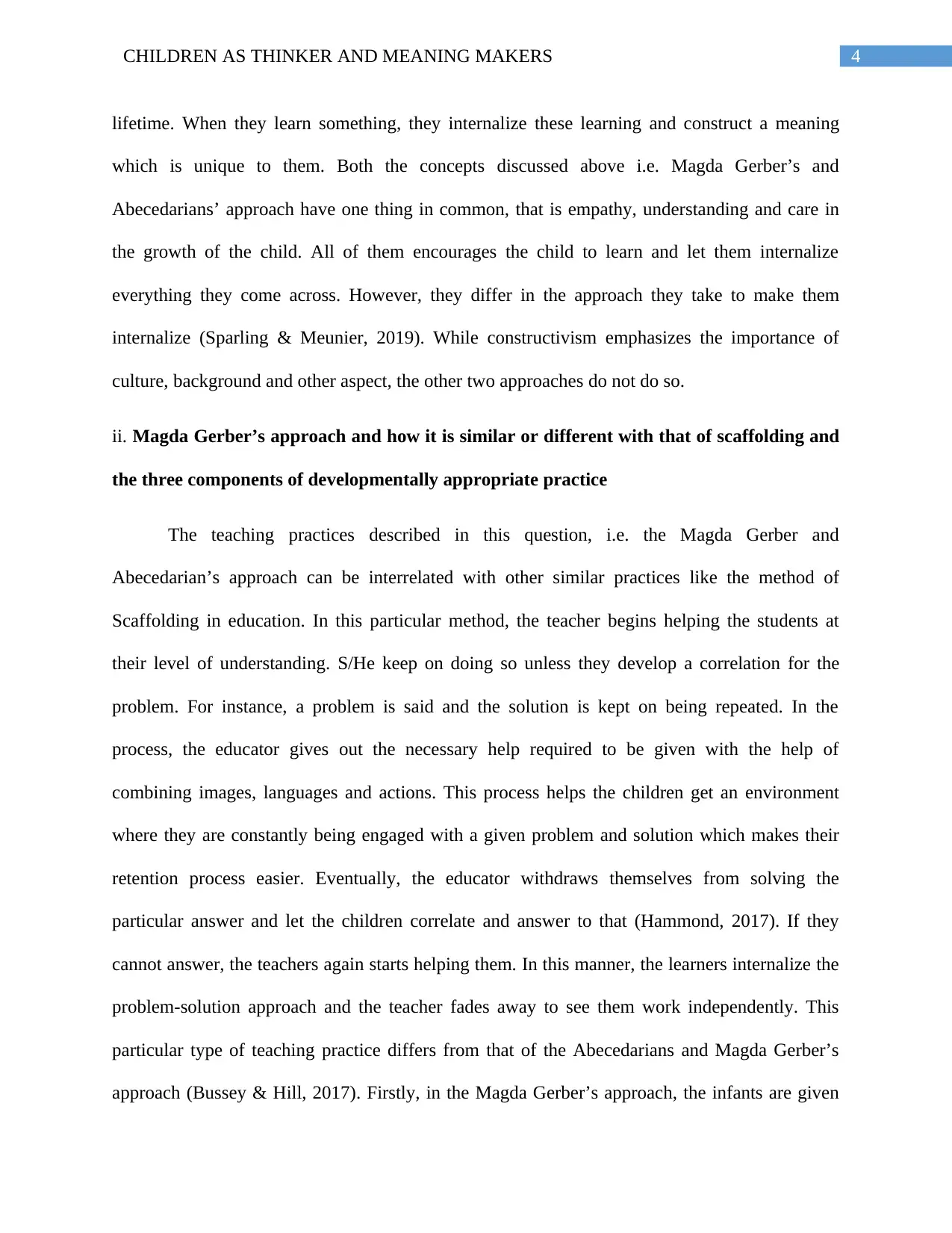
4CHILDREN AS THINKER AND MEANING MAKERS
lifetime. When they learn something, they internalize these learning and construct a meaning
which is unique to them. Both the concepts discussed above i.e. Magda Gerber’s and
Abecedarians’ approach have one thing in common, that is empathy, understanding and care in
the growth of the child. All of them encourages the child to learn and let them internalize
everything they come across. However, they differ in the approach they take to make them
internalize (Sparling & Meunier, 2019). While constructivism emphasizes the importance of
culture, background and other aspect, the other two approaches do not do so.
ii. Magda Gerber’s approach and how it is similar or different with that of scaffolding and
the three components of developmentally appropriate practice
The teaching practices described in this question, i.e. the Magda Gerber and
Abecedarian’s approach can be interrelated with other similar practices like the method of
Scaffolding in education. In this particular method, the teacher begins helping the students at
their level of understanding. S/He keep on doing so unless they develop a correlation for the
problem. For instance, a problem is said and the solution is kept on being repeated. In the
process, the educator gives out the necessary help required to be given with the help of
combining images, languages and actions. This process helps the children get an environment
where they are constantly being engaged with a given problem and solution which makes their
retention process easier. Eventually, the educator withdraws themselves from solving the
particular answer and let the children correlate and answer to that (Hammond, 2017). If they
cannot answer, the teachers again starts helping them. In this manner, the learners internalize the
problem-solution approach and the teacher fades away to see them work independently. This
particular type of teaching practice differs from that of the Abecedarians and Magda Gerber’s
approach (Bussey & Hill, 2017). Firstly, in the Magda Gerber’s approach, the infants are given
lifetime. When they learn something, they internalize these learning and construct a meaning
which is unique to them. Both the concepts discussed above i.e. Magda Gerber’s and
Abecedarians’ approach have one thing in common, that is empathy, understanding and care in
the growth of the child. All of them encourages the child to learn and let them internalize
everything they come across. However, they differ in the approach they take to make them
internalize (Sparling & Meunier, 2019). While constructivism emphasizes the importance of
culture, background and other aspect, the other two approaches do not do so.
ii. Magda Gerber’s approach and how it is similar or different with that of scaffolding and
the three components of developmentally appropriate practice
The teaching practices described in this question, i.e. the Magda Gerber and
Abecedarian’s approach can be interrelated with other similar practices like the method of
Scaffolding in education. In this particular method, the teacher begins helping the students at
their level of understanding. S/He keep on doing so unless they develop a correlation for the
problem. For instance, a problem is said and the solution is kept on being repeated. In the
process, the educator gives out the necessary help required to be given with the help of
combining images, languages and actions. This process helps the children get an environment
where they are constantly being engaged with a given problem and solution which makes their
retention process easier. Eventually, the educator withdraws themselves from solving the
particular answer and let the children correlate and answer to that (Hammond, 2017). If they
cannot answer, the teachers again starts helping them. In this manner, the learners internalize the
problem-solution approach and the teacher fades away to see them work independently. This
particular type of teaching practice differs from that of the Abecedarians and Magda Gerber’s
approach (Bussey & Hill, 2017). Firstly, in the Magda Gerber’s approach, the infants are given
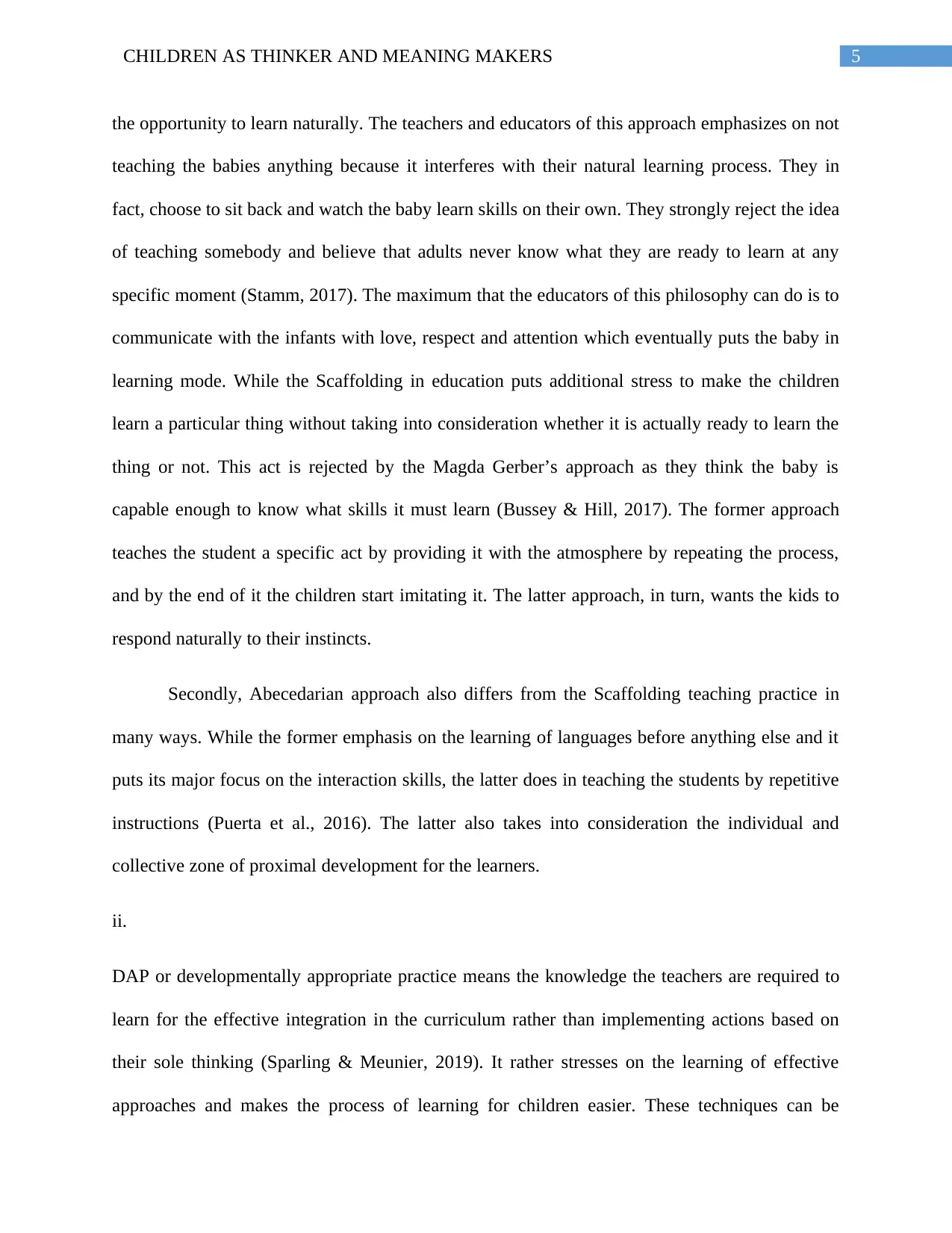
5CHILDREN AS THINKER AND MEANING MAKERS
the opportunity to learn naturally. The teachers and educators of this approach emphasizes on not
teaching the babies anything because it interferes with their natural learning process. They in
fact, choose to sit back and watch the baby learn skills on their own. They strongly reject the idea
of teaching somebody and believe that adults never know what they are ready to learn at any
specific moment (Stamm, 2017). The maximum that the educators of this philosophy can do is to
communicate with the infants with love, respect and attention which eventually puts the baby in
learning mode. While the Scaffolding in education puts additional stress to make the children
learn a particular thing without taking into consideration whether it is actually ready to learn the
thing or not. This act is rejected by the Magda Gerber’s approach as they think the baby is
capable enough to know what skills it must learn (Bussey & Hill, 2017). The former approach
teaches the student a specific act by providing it with the atmosphere by repeating the process,
and by the end of it the children start imitating it. The latter approach, in turn, wants the kids to
respond naturally to their instincts.
Secondly, Abecedarian approach also differs from the Scaffolding teaching practice in
many ways. While the former emphasis on the learning of languages before anything else and it
puts its major focus on the interaction skills, the latter does in teaching the students by repetitive
instructions (Puerta et al., 2016). The latter also takes into consideration the individual and
collective zone of proximal development for the learners.
ii.
DAP or developmentally appropriate practice means the knowledge the teachers are required to
learn for the effective integration in the curriculum rather than implementing actions based on
their sole thinking (Sparling & Meunier, 2019). It rather stresses on the learning of effective
approaches and makes the process of learning for children easier. These techniques can be
the opportunity to learn naturally. The teachers and educators of this approach emphasizes on not
teaching the babies anything because it interferes with their natural learning process. They in
fact, choose to sit back and watch the baby learn skills on their own. They strongly reject the idea
of teaching somebody and believe that adults never know what they are ready to learn at any
specific moment (Stamm, 2017). The maximum that the educators of this philosophy can do is to
communicate with the infants with love, respect and attention which eventually puts the baby in
learning mode. While the Scaffolding in education puts additional stress to make the children
learn a particular thing without taking into consideration whether it is actually ready to learn the
thing or not. This act is rejected by the Magda Gerber’s approach as they think the baby is
capable enough to know what skills it must learn (Bussey & Hill, 2017). The former approach
teaches the student a specific act by providing it with the atmosphere by repeating the process,
and by the end of it the children start imitating it. The latter approach, in turn, wants the kids to
respond naturally to their instincts.
Secondly, Abecedarian approach also differs from the Scaffolding teaching practice in
many ways. While the former emphasis on the learning of languages before anything else and it
puts its major focus on the interaction skills, the latter does in teaching the students by repetitive
instructions (Puerta et al., 2016). The latter also takes into consideration the individual and
collective zone of proximal development for the learners.
ii.
DAP or developmentally appropriate practice means the knowledge the teachers are required to
learn for the effective integration in the curriculum rather than implementing actions based on
their sole thinking (Sparling & Meunier, 2019). It rather stresses on the learning of effective
approaches and makes the process of learning for children easier. These techniques can be
⊘ This is a preview!⊘
Do you want full access?
Subscribe today to unlock all pages.

Trusted by 1+ million students worldwide
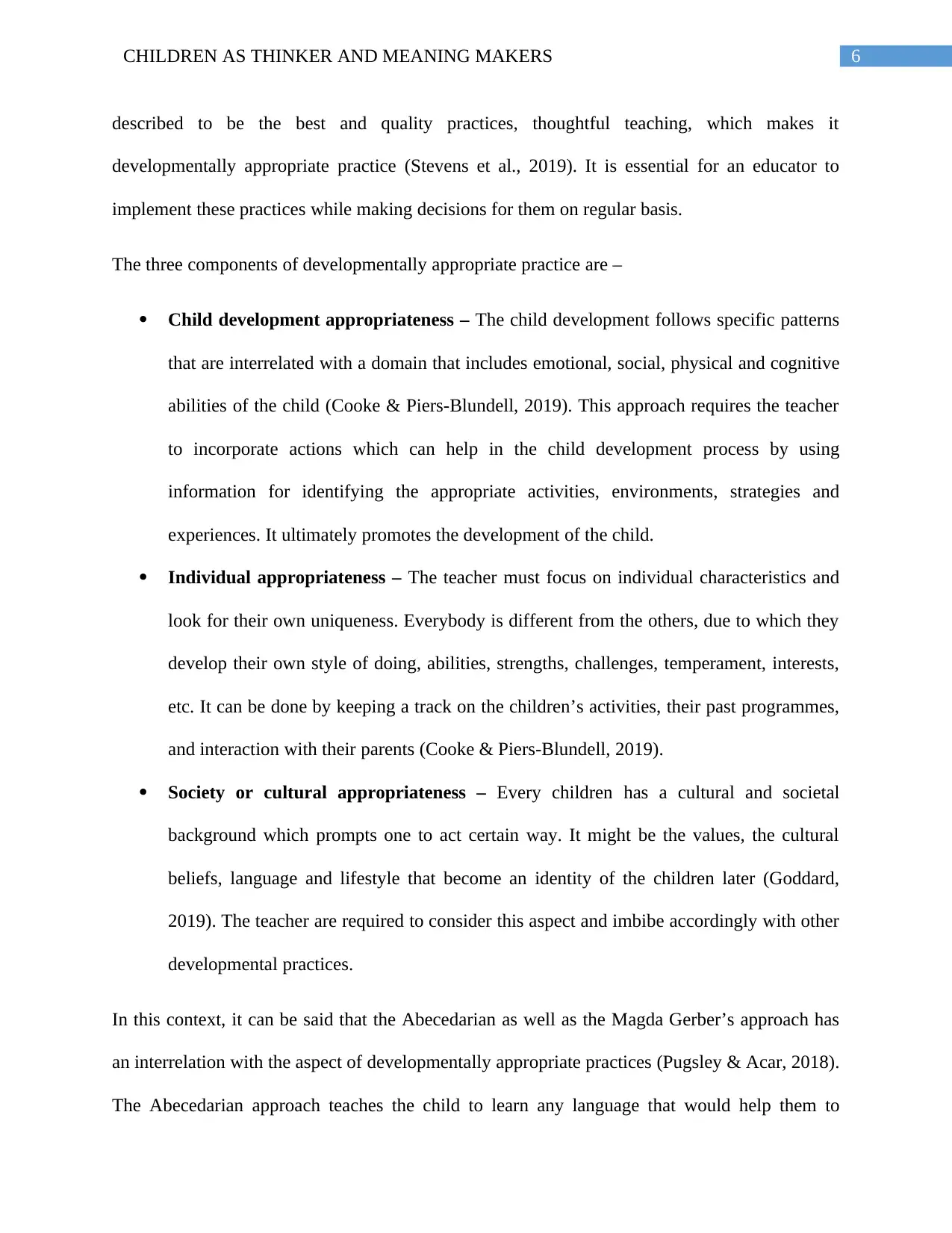
6CHILDREN AS THINKER AND MEANING MAKERS
described to be the best and quality practices, thoughtful teaching, which makes it
developmentally appropriate practice (Stevens et al., 2019). It is essential for an educator to
implement these practices while making decisions for them on regular basis.
The three components of developmentally appropriate practice are –
Child development appropriateness – The child development follows specific patterns
that are interrelated with a domain that includes emotional, social, physical and cognitive
abilities of the child (Cooke & Piers-Blundell, 2019). This approach requires the teacher
to incorporate actions which can help in the child development process by using
information for identifying the appropriate activities, environments, strategies and
experiences. It ultimately promotes the development of the child.
Individual appropriateness – The teacher must focus on individual characteristics and
look for their own uniqueness. Everybody is different from the others, due to which they
develop their own style of doing, abilities, strengths, challenges, temperament, interests,
etc. It can be done by keeping a track on the children’s activities, their past programmes,
and interaction with their parents (Cooke & Piers-Blundell, 2019).
Society or cultural appropriateness – Every children has a cultural and societal
background which prompts one to act certain way. It might be the values, the cultural
beliefs, language and lifestyle that become an identity of the children later (Goddard,
2019). The teacher are required to consider this aspect and imbibe accordingly with other
developmental practices.
In this context, it can be said that the Abecedarian as well as the Magda Gerber’s approach has
an interrelation with the aspect of developmentally appropriate practices (Pugsley & Acar, 2018).
The Abecedarian approach teaches the child to learn any language that would help them to
described to be the best and quality practices, thoughtful teaching, which makes it
developmentally appropriate practice (Stevens et al., 2019). It is essential for an educator to
implement these practices while making decisions for them on regular basis.
The three components of developmentally appropriate practice are –
Child development appropriateness – The child development follows specific patterns
that are interrelated with a domain that includes emotional, social, physical and cognitive
abilities of the child (Cooke & Piers-Blundell, 2019). This approach requires the teacher
to incorporate actions which can help in the child development process by using
information for identifying the appropriate activities, environments, strategies and
experiences. It ultimately promotes the development of the child.
Individual appropriateness – The teacher must focus on individual characteristics and
look for their own uniqueness. Everybody is different from the others, due to which they
develop their own style of doing, abilities, strengths, challenges, temperament, interests,
etc. It can be done by keeping a track on the children’s activities, their past programmes,
and interaction with their parents (Cooke & Piers-Blundell, 2019).
Society or cultural appropriateness – Every children has a cultural and societal
background which prompts one to act certain way. It might be the values, the cultural
beliefs, language and lifestyle that become an identity of the children later (Goddard,
2019). The teacher are required to consider this aspect and imbibe accordingly with other
developmental practices.
In this context, it can be said that the Abecedarian as well as the Magda Gerber’s approach has
an interrelation with the aspect of developmentally appropriate practices (Pugsley & Acar, 2018).
The Abecedarian approach teaches the child to learn any language that would help them to
Paraphrase This Document
Need a fresh take? Get an instant paraphrase of this document with our AI Paraphraser
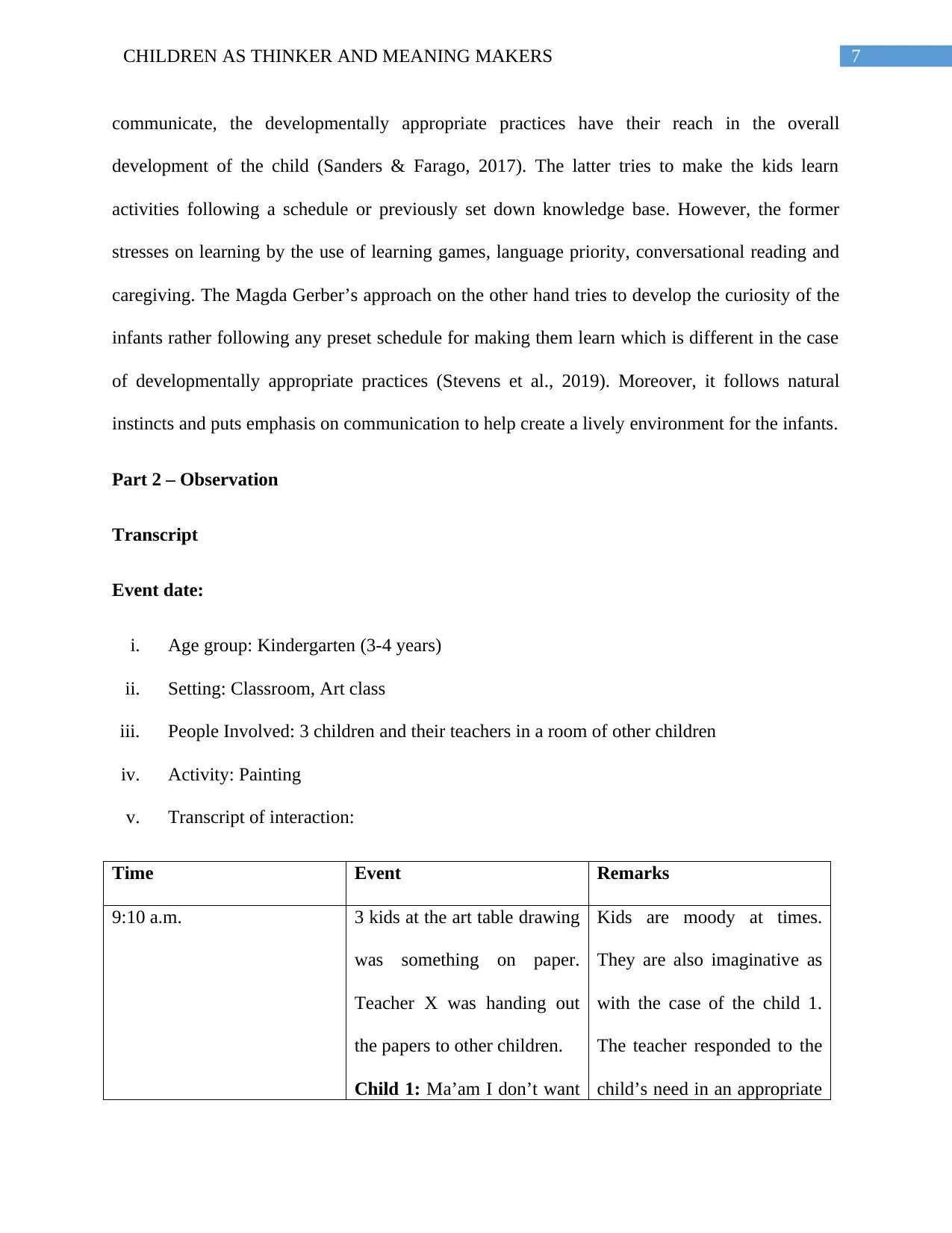
7CHILDREN AS THINKER AND MEANING MAKERS
communicate, the developmentally appropriate practices have their reach in the overall
development of the child (Sanders & Farago, 2017). The latter tries to make the kids learn
activities following a schedule or previously set down knowledge base. However, the former
stresses on learning by the use of learning games, language priority, conversational reading and
caregiving. The Magda Gerber’s approach on the other hand tries to develop the curiosity of the
infants rather following any preset schedule for making them learn which is different in the case
of developmentally appropriate practices (Stevens et al., 2019). Moreover, it follows natural
instincts and puts emphasis on communication to help create a lively environment for the infants.
Part 2 – Observation
Transcript
Event date:
i. Age group: Kindergarten (3-4 years)
ii. Setting: Classroom, Art class
iii. People Involved: 3 children and their teachers in a room of other children
iv. Activity: Painting
v. Transcript of interaction:
Time Event Remarks
9:10 a.m. 3 kids at the art table drawing
was something on paper.
Teacher X was handing out
the papers to other children.
Child 1: Ma’am I don’t want
Kids are moody at times.
They are also imaginative as
with the case of the child 1.
The teacher responded to the
child’s need in an appropriate
communicate, the developmentally appropriate practices have their reach in the overall
development of the child (Sanders & Farago, 2017). The latter tries to make the kids learn
activities following a schedule or previously set down knowledge base. However, the former
stresses on learning by the use of learning games, language priority, conversational reading and
caregiving. The Magda Gerber’s approach on the other hand tries to develop the curiosity of the
infants rather following any preset schedule for making them learn which is different in the case
of developmentally appropriate practices (Stevens et al., 2019). Moreover, it follows natural
instincts and puts emphasis on communication to help create a lively environment for the infants.
Part 2 – Observation
Transcript
Event date:
i. Age group: Kindergarten (3-4 years)
ii. Setting: Classroom, Art class
iii. People Involved: 3 children and their teachers in a room of other children
iv. Activity: Painting
v. Transcript of interaction:
Time Event Remarks
9:10 a.m. 3 kids at the art table drawing
was something on paper.
Teacher X was handing out
the papers to other children.
Child 1: Ma’am I don’t want
Kids are moody at times.
They are also imaginative as
with the case of the child 1.
The teacher responded to the
child’s need in an appropriate
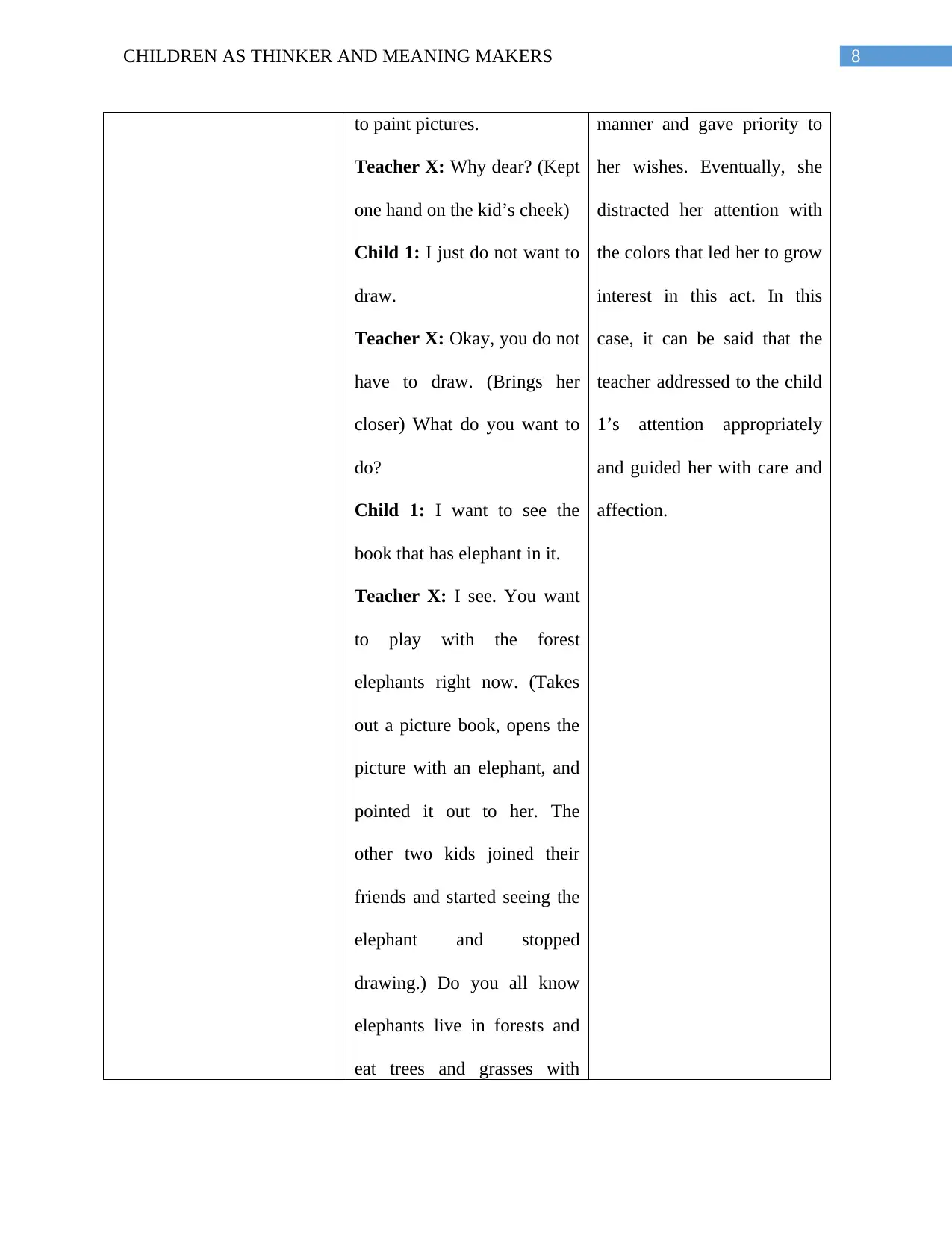
8CHILDREN AS THINKER AND MEANING MAKERS
to paint pictures.
Teacher X: Why dear? (Kept
one hand on the kid’s cheek)
Child 1: I just do not want to
draw.
Teacher X: Okay, you do not
have to draw. (Brings her
closer) What do you want to
do?
Child 1: I want to see the
book that has elephant in it.
Teacher X: I see. You want
to play with the forest
elephants right now. (Takes
out a picture book, opens the
picture with an elephant, and
pointed it out to her. The
other two kids joined their
friends and started seeing the
elephant and stopped
drawing.) Do you all know
elephants live in forests and
eat trees and grasses with
manner and gave priority to
her wishes. Eventually, she
distracted her attention with
the colors that led her to grow
interest in this act. In this
case, it can be said that the
teacher addressed to the child
1’s attention appropriately
and guided her with care and
affection.
to paint pictures.
Teacher X: Why dear? (Kept
one hand on the kid’s cheek)
Child 1: I just do not want to
draw.
Teacher X: Okay, you do not
have to draw. (Brings her
closer) What do you want to
do?
Child 1: I want to see the
book that has elephant in it.
Teacher X: I see. You want
to play with the forest
elephants right now. (Takes
out a picture book, opens the
picture with an elephant, and
pointed it out to her. The
other two kids joined their
friends and started seeing the
elephant and stopped
drawing.) Do you all know
elephants live in forests and
eat trees and grasses with
manner and gave priority to
her wishes. Eventually, she
distracted her attention with
the colors that led her to grow
interest in this act. In this
case, it can be said that the
teacher addressed to the child
1’s attention appropriately
and guided her with care and
affection.
⊘ This is a preview!⊘
Do you want full access?
Subscribe today to unlock all pages.

Trusted by 1+ million students worldwide
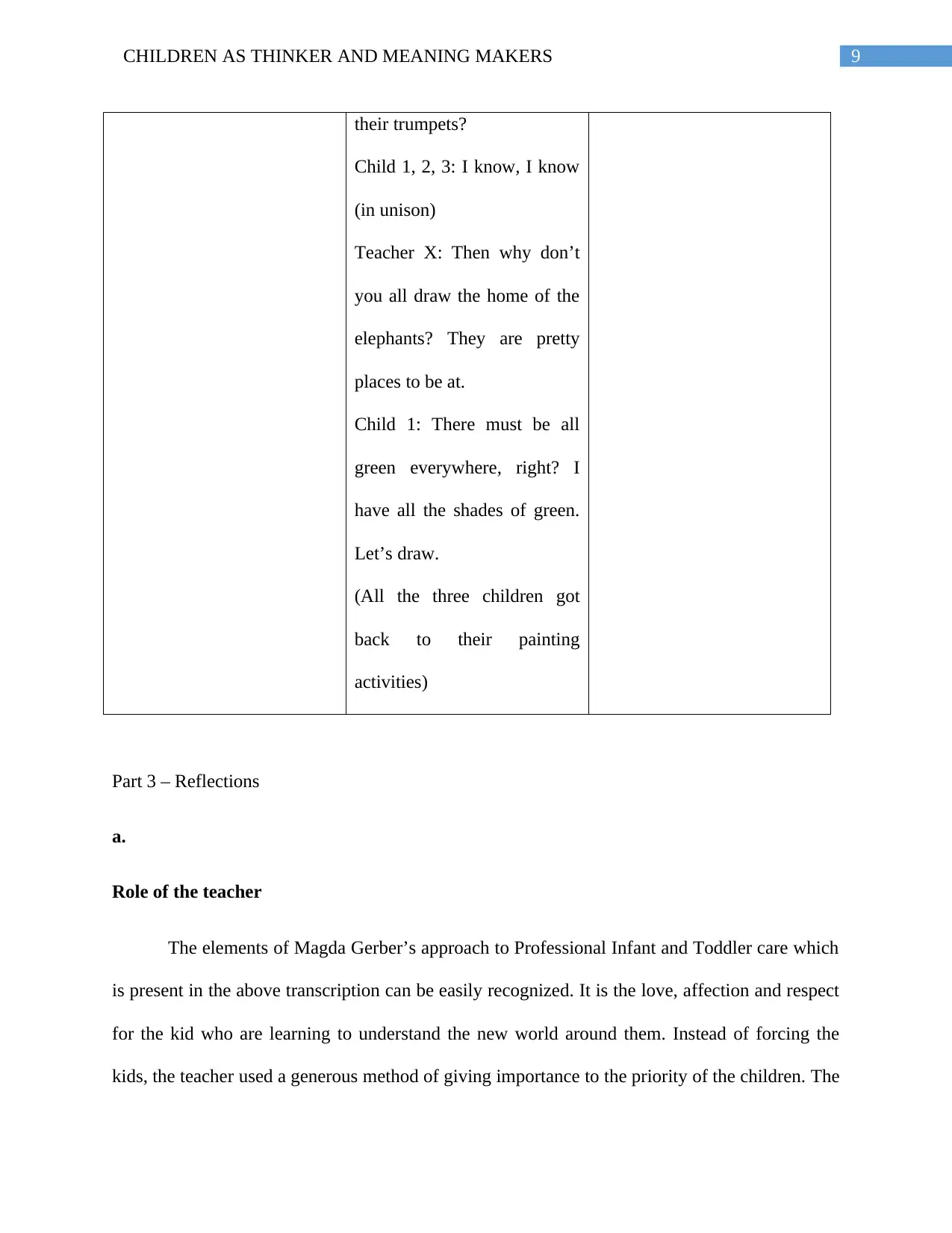
9CHILDREN AS THINKER AND MEANING MAKERS
their trumpets?
Child 1, 2, 3: I know, I know
(in unison)
Teacher X: Then why don’t
you all draw the home of the
elephants? They are pretty
places to be at.
Child 1: There must be all
green everywhere, right? I
have all the shades of green.
Let’s draw.
(All the three children got
back to their painting
activities)
Part 3 – Reflections
a.
Role of the teacher
The elements of Magda Gerber’s approach to Professional Infant and Toddler care which
is present in the above transcription can be easily recognized. It is the love, affection and respect
for the kid who are learning to understand the new world around them. Instead of forcing the
kids, the teacher used a generous method of giving importance to the priority of the children. The
their trumpets?
Child 1, 2, 3: I know, I know
(in unison)
Teacher X: Then why don’t
you all draw the home of the
elephants? They are pretty
places to be at.
Child 1: There must be all
green everywhere, right? I
have all the shades of green.
Let’s draw.
(All the three children got
back to their painting
activities)
Part 3 – Reflections
a.
Role of the teacher
The elements of Magda Gerber’s approach to Professional Infant and Toddler care which
is present in the above transcription can be easily recognized. It is the love, affection and respect
for the kid who are learning to understand the new world around them. Instead of forcing the
kids, the teacher used a generous method of giving importance to the priority of the children. The
Paraphrase This Document
Need a fresh take? Get an instant paraphrase of this document with our AI Paraphraser
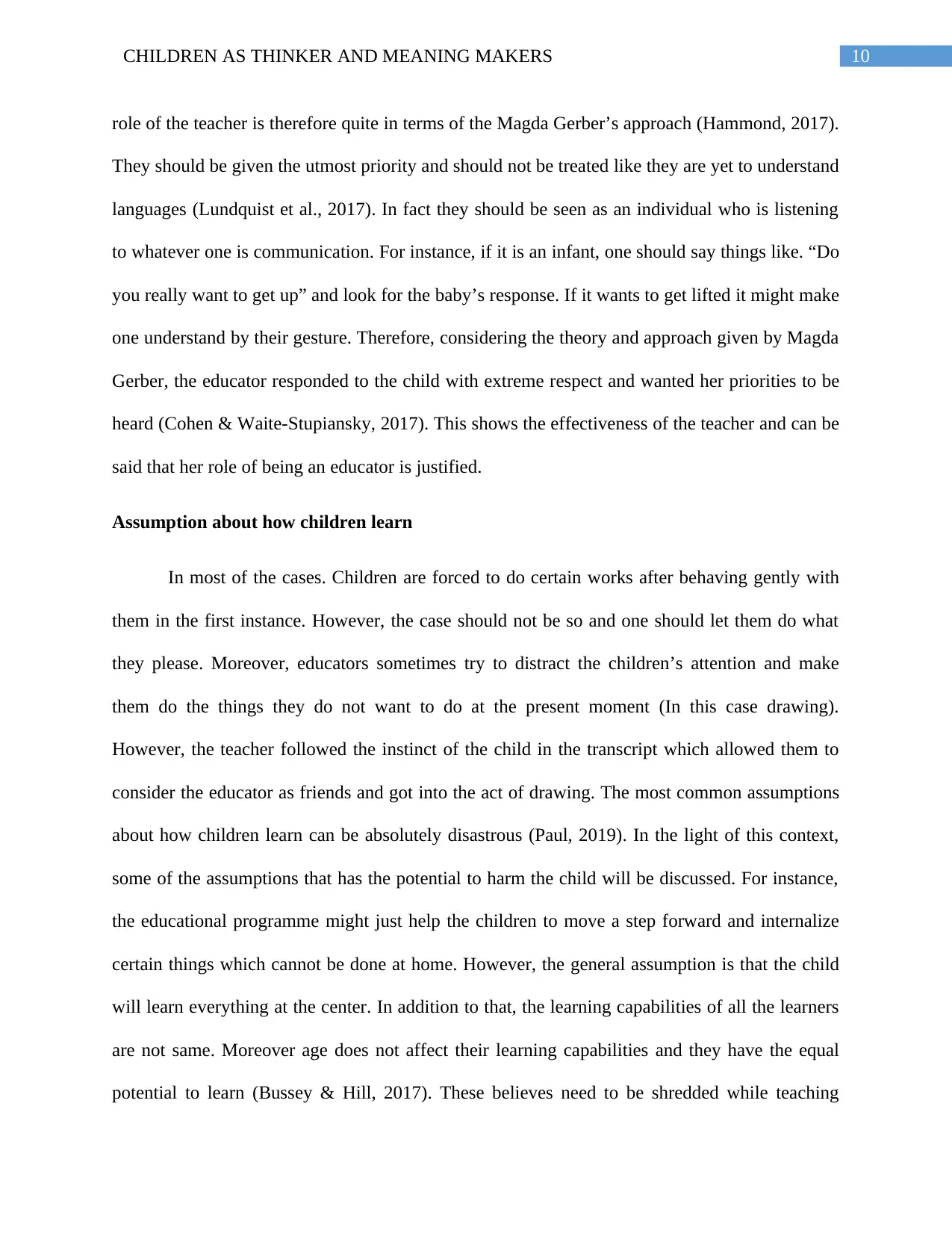
10CHILDREN AS THINKER AND MEANING MAKERS
role of the teacher is therefore quite in terms of the Magda Gerber’s approach (Hammond, 2017).
They should be given the utmost priority and should not be treated like they are yet to understand
languages (Lundquist et al., 2017). In fact they should be seen as an individual who is listening
to whatever one is communication. For instance, if it is an infant, one should say things like. “Do
you really want to get up” and look for the baby’s response. If it wants to get lifted it might make
one understand by their gesture. Therefore, considering the theory and approach given by Magda
Gerber, the educator responded to the child with extreme respect and wanted her priorities to be
heard (Cohen & Waite-Stupiansky, 2017). This shows the effectiveness of the teacher and can be
said that her role of being an educator is justified.
Assumption about how children learn
In most of the cases. Children are forced to do certain works after behaving gently with
them in the first instance. However, the case should not be so and one should let them do what
they please. Moreover, educators sometimes try to distract the children’s attention and make
them do the things they do not want to do at the present moment (In this case drawing).
However, the teacher followed the instinct of the child in the transcript which allowed them to
consider the educator as friends and got into the act of drawing. The most common assumptions
about how children learn can be absolutely disastrous (Paul, 2019). In the light of this context,
some of the assumptions that has the potential to harm the child will be discussed. For instance,
the educational programme might just help the children to move a step forward and internalize
certain things which cannot be done at home. However, the general assumption is that the child
will learn everything at the center. In addition to that, the learning capabilities of all the learners
are not same. Moreover age does not affect their learning capabilities and they have the equal
potential to learn (Bussey & Hill, 2017). These believes need to be shredded while teaching
role of the teacher is therefore quite in terms of the Magda Gerber’s approach (Hammond, 2017).
They should be given the utmost priority and should not be treated like they are yet to understand
languages (Lundquist et al., 2017). In fact they should be seen as an individual who is listening
to whatever one is communication. For instance, if it is an infant, one should say things like. “Do
you really want to get up” and look for the baby’s response. If it wants to get lifted it might make
one understand by their gesture. Therefore, considering the theory and approach given by Magda
Gerber, the educator responded to the child with extreme respect and wanted her priorities to be
heard (Cohen & Waite-Stupiansky, 2017). This shows the effectiveness of the teacher and can be
said that her role of being an educator is justified.
Assumption about how children learn
In most of the cases. Children are forced to do certain works after behaving gently with
them in the first instance. However, the case should not be so and one should let them do what
they please. Moreover, educators sometimes try to distract the children’s attention and make
them do the things they do not want to do at the present moment (In this case drawing).
However, the teacher followed the instinct of the child in the transcript which allowed them to
consider the educator as friends and got into the act of drawing. The most common assumptions
about how children learn can be absolutely disastrous (Paul, 2019). In the light of this context,
some of the assumptions that has the potential to harm the child will be discussed. For instance,
the educational programme might just help the children to move a step forward and internalize
certain things which cannot be done at home. However, the general assumption is that the child
will learn everything at the center. In addition to that, the learning capabilities of all the learners
are not same. Moreover age does not affect their learning capabilities and they have the equal
potential to learn (Bussey & Hill, 2017). These believes need to be shredded while teaching
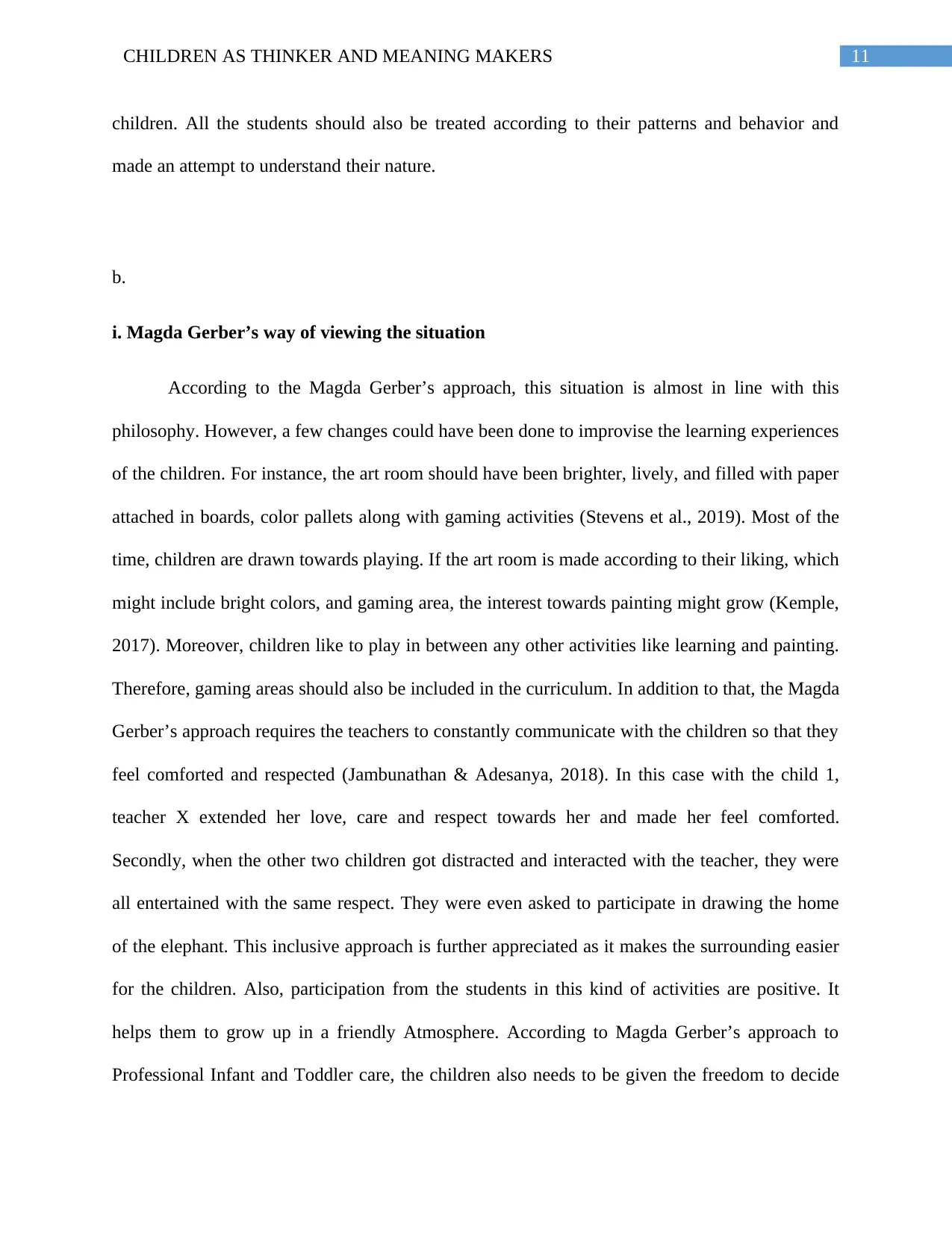
11CHILDREN AS THINKER AND MEANING MAKERS
children. All the students should also be treated according to their patterns and behavior and
made an attempt to understand their nature.
b.
i. Magda Gerber’s way of viewing the situation
According to the Magda Gerber’s approach, this situation is almost in line with this
philosophy. However, a few changes could have been done to improvise the learning experiences
of the children. For instance, the art room should have been brighter, lively, and filled with paper
attached in boards, color pallets along with gaming activities (Stevens et al., 2019). Most of the
time, children are drawn towards playing. If the art room is made according to their liking, which
might include bright colors, and gaming area, the interest towards painting might grow (Kemple,
2017). Moreover, children like to play in between any other activities like learning and painting.
Therefore, gaming areas should also be included in the curriculum. In addition to that, the Magda
Gerber’s approach requires the teachers to constantly communicate with the children so that they
feel comforted and respected (Jambunathan & Adesanya, 2018). In this case with the child 1,
teacher X extended her love, care and respect towards her and made her feel comforted.
Secondly, when the other two children got distracted and interacted with the teacher, they were
all entertained with the same respect. They were even asked to participate in drawing the home
of the elephant. This inclusive approach is further appreciated as it makes the surrounding easier
for the children. Also, participation from the students in this kind of activities are positive. It
helps them to grow up in a friendly Atmosphere. According to Magda Gerber’s approach to
Professional Infant and Toddler care, the children also needs to be given the freedom to decide
children. All the students should also be treated according to their patterns and behavior and
made an attempt to understand their nature.
b.
i. Magda Gerber’s way of viewing the situation
According to the Magda Gerber’s approach, this situation is almost in line with this
philosophy. However, a few changes could have been done to improvise the learning experiences
of the children. For instance, the art room should have been brighter, lively, and filled with paper
attached in boards, color pallets along with gaming activities (Stevens et al., 2019). Most of the
time, children are drawn towards playing. If the art room is made according to their liking, which
might include bright colors, and gaming area, the interest towards painting might grow (Kemple,
2017). Moreover, children like to play in between any other activities like learning and painting.
Therefore, gaming areas should also be included in the curriculum. In addition to that, the Magda
Gerber’s approach requires the teachers to constantly communicate with the children so that they
feel comforted and respected (Jambunathan & Adesanya, 2018). In this case with the child 1,
teacher X extended her love, care and respect towards her and made her feel comforted.
Secondly, when the other two children got distracted and interacted with the teacher, they were
all entertained with the same respect. They were even asked to participate in drawing the home
of the elephant. This inclusive approach is further appreciated as it makes the surrounding easier
for the children. Also, participation from the students in this kind of activities are positive. It
helps them to grow up in a friendly Atmosphere. According to Magda Gerber’s approach to
Professional Infant and Toddler care, the children also needs to be given the freedom to decide
⊘ This is a preview!⊘
Do you want full access?
Subscribe today to unlock all pages.

Trusted by 1+ million students worldwide
1 out of 21
Your All-in-One AI-Powered Toolkit for Academic Success.
+13062052269
info@desklib.com
Available 24*7 on WhatsApp / Email
![[object Object]](/_next/static/media/star-bottom.7253800d.svg)
Unlock your academic potential
Copyright © 2020–2025 A2Z Services. All Rights Reserved. Developed and managed by ZUCOL.
